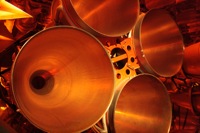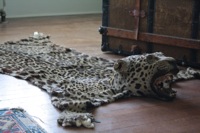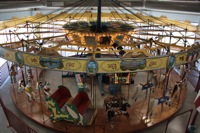
It was a race across the plains and against the clock — I had 10 Kansas towns to visit and four days to visit them. You may call it a whirlwind tour, but in this part of the country, it might be more appropriate to call it a twister.
From Kansas City to Topeka, Manhattan, Salina and Hutchinson, Kansas’ cities and towns offer a wide variety of attractions, from Civil War-era historic sites to a world-class space museum and charming little arts communities. During my tour, I packed in as many as I could: I took a ride on an old carousel in Leavenworth, enjoyed a gourmet chocolate shop in Topeka and visited a classic car college in McPherson.
I covered hundreds of miles of highway between the stops. Although it all went by quickly, looking back, I’m surprised by just how much I was able to see. There were more attractions than we have space to cover here, but you’ll find highlights that reflect the wide variety of history, culture and classic American flavor that makes Kansas a great state to tour — even in a hurry.
Red Barn Studio
Lindsborg
Lindsborg is a small Kansas town with a big Swedish heritage. Visitors can enjoy Swedish pastries and crafts, as well as a significant artistic community in the small downtown.
 One of the most interesting stops for art lovers is Red Barn Studio, the workplace of local artist Lester Raymer. Although he was born in Chicago, Raymer spent most of his life in Lindsborg, and worked in the converted barn studio from 1945 until his death in 1991.
One of the most interesting stops for art lovers is Red Barn Studio, the workplace of local artist Lester Raymer. Although he was born in Chicago, Raymer spent most of his life in Lindsborg, and worked in the converted barn studio from 1945 until his death in 1991.
During a tour, groups can see the artist’s studio workbench and tools, along with dozens of pieces of his work. Items on display range from paintings and pottery to tapestries and large pieces of furniture made with found items and recycled materials.
Among the most interesting works is a collection of toys that he created for his wife, Ramona.
“Over a 30-year period, he made 56 toys for Ramona,” said the site’s director, Marsha Howe. “Almost all of them had clown themes.”
Candles and candies
Topeka
Two downtown shops in Topeka make great, interactive stops for tour groups — and they sit right across the street from each other.
At Marion Lane Candles, visitors can learn about how this local company makes custom scented candles, and the proprietors offer groups a chance to make their own.
“We have chunks of wax that are scented,” said owner Connie Cook. “We can get fragrances in really neat things, like popcorn or fresh-mowed grass. We try to carry things that you can’t find at just any candle store.”
Across the street, Hazel Hill Chocolate Traditions is a confectionary that specializes in chocolate and caramel candies. Visitors can sample handmade truffles, chocolate-dipped cherries and apples, and the creatively named “Things” — moist bits of brownies or cakes coated in chocolate.
“When groups come, we make fudge for them on our marble slab,” said the store’s Donna Zimmerman. “We tell you some about chocolate and the history of Hazel Hill, and then you get to dip half a pretzel in chocolate.”
www.marionlanecandles.com
www.hazelhillchocolate.com
McPherson College Automotive Restoration
McPherson
At McPherson College in McPherson, more than 100 students are enrolled in the school’s Automotive Restoration Technology program, the only course of study in the country that offers four-year degrees in restoration of classic cars. When group tours visit town, the local convention and visitors bureau can arrange a behind-the-scenes tour in the workshops.
 “We explain a little bit about the history of the program,” said Chris Paulson, one of the school’s instructors. “We take them through the different parts of restoring old cars, from the workshops to the showroom.”
“We explain a little bit about the history of the program,” said Chris Paulson, one of the school’s instructors. “We take them through the different parts of restoring old cars, from the workshops to the showroom.”
Students work on cars that were produced between 1908 and 1967, rebuilding the engines, detailing the interiors and restoring the chrome and paint on the outside. Several of the school’s biggest successes are on display in a showroom at the front of the building, and the school hosts an annual classic-car show in May.
www.mcpherson.edu/technology/
Kansas Cosmosphere and Space Center
Hutchinson
The troubled Apollo 13 space mission nearly didn’t return to earth; once it did, though, many of its pieces found their way back to the Kansas Cosmosphere and Space Museum. This massive museum is the second-largest space museum in the world, after the Smithsonian, and houses the largest collection of Soviet spacecraft outside of Russia.
 “The museum basically tells the story of the space race,” said public relations coordinator Patsy Terrell. “We do it with no bias: We tell the Russian side and the American side.”
“The museum basically tells the story of the space race,” said public relations coordinator Patsy Terrell. “We do it with no bias: We tell the Russian side and the American side.”
The list of impressive artifacts at the museum is extensive. The highlight is the Apollo 13 command module, which is accompanied by some 80,000 other pieces of the Apollo.
Visitors can also stand in the “white room,” the high-tech gangway that astronauts crossed to enter the Apollo spacecraft, or see a reproduction of a lunar rover built by the company that created the original lunar vehicle, which is still on the moon today.
William Allen White State Historic Site
Emporia
You may not know the name William Allen White, but during the early 1900s, this Emporia newspaper owner and editor became quite an influential figure. White was a personal friend of seven U.S. presidents; he advised six of them, and five came to visit him at his home in Emporia.
 Today, that home is the William Allen White State Historic Site. The red sandstone house, built in the 1880s, became a public museum in the mid-1990s, 100 years after White’s family first moved in.
Today, that home is the William Allen White State Historic Site. The red sandstone house, built in the 1880s, became a public museum in the mid-1990s, 100 years after White’s family first moved in.
“One of the big attractions is that 90 percent of the stuff in the house was owned by the Whites,” said site administrator Nick Gronseth. “Everything is set up as it would have looked in the 1920s.”
The house features a number of notable antiques and other items, such as a set of 400-year-old dining room chairs that had belonged to the Medici family of Italy. In an upstairs bedroom, visitors will see the skin and head of a jaguar that Theodore Roosevelt shot and presented to White as a gift.
www.kshs.org/places/white/index.htm
Flint Hills
Manhattan
Though it’s best known as a college town, Manhattan is also the gateway to the Flint Hills, a geological region that reaches from Kansas into northern Oklahoma.
 |
| Courtesy Flint Hills Tall Grass/em> |
“The Flint Hills is a remarkable place,” said Bob Workman, director of the Flint Hills Discovery Center. “It’s 4 million acres. Because the limestone is so close to the surface, it could not be broken by the plow. So now we’re the custodians of the last tall-grass prairie in North America.”
Groups interested in learning more about the Flint Hills can visit the Konza Prairie Research Natural Area, a spot just outside of Manhattan where scientists study the Flint Hills geology and the buffalo and other animals that make their home there. Visitors often see groups of wild turkeys or white-tailed deer at the 8,600-acre site, and can hike several trails in the area, one of which leads to a preserved 1870s Swedish homestead.
In 2012, the new Flint Hills Discovery Center will open in Manhattan; the center will give visitors a comprehensive museum overview of the region.
www.hilferty.com/flinthills/index.html
Rolling Hills Wildlife Adventure
Salina
What began as a team of Belgian horses in a local man’s barn has turned into Rolling Hills Wildlife Adventure, a zoo and museum in Salina that gives guests an up-close look at animals from around the world.
 |
| Courtesy Rolling Hills Wildlife Adventure |
Salina businessman Charlie Walker welcomed school groups to his farm for years to see the horses, and in 1999, he opened a more formal zoo on the site. Today, the zoo has large and exotic animals from all over the world, including rhinoceroses, orangutans, leopards, lions, tigers and a host of others.
Groups can take a tram tour through the zoo, where they see as many as 130 species. There are hundreds more on display in the accompanying museum, which also showcases an impressive collection of mounted animals surrounded by scenery from their native parts of the world.
“Most of these mounts come from a man who had a collection in California,” said group sales manager Debbie Tasker. “He wanted to keep the collection together, so we got it in its entirety. It took semi trucks to bring this collection here.”
C.W. Parker Carousel Museum
Leavenworth
Throughout the first half of the 20th century, the C.W. Parker Company manufactured hand-carved wooden carousels in Leavenworth, which were installed all over the country. Today, the community has gathered a number of pieces of Parker Carousel memorabilia, including several working carousels, and displays them at the C.W. Parker Carousel Museum.
 The centerpiece of the museum is a 1916 carousel, which was originally built in Leavenworth and recently repurchased for the museum. A volunteer staff spent hundreds of hours restoring the carousel and repainting its wooden figures. Today, visitors can take a ride on the finished product, which is complete with a working automatic music machine.
The centerpiece of the museum is a 1916 carousel, which was originally built in Leavenworth and recently repurchased for the museum. A volunteer staff spent hundreds of hours restoring the carousel and repainting its wooden figures. Today, visitors can take a ride on the finished product, which is complete with a working automatic music machine.
Groups visiting the museum can see a number of other working carousels, including an 1850s model that is the oldest operating carousel in the United States. Another large exhibit area has dozens of hand-carved figures from historic Parker carousels.
“Some of these belonged to individuals,” said museum guide Larry Tate. “People send them to us. They want them in this museum, because this is where they were made.”
For More Information:
WEB EXCLUSIVE! Itinerary ideas from Grand Central USA









